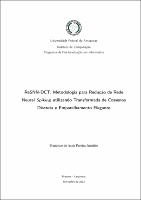| ???jsp.display-item.social.title??? |


|
Please use this identifier to cite or link to this item:
https://tede.ufam.edu.br/handle/tede/9230| ???metadata.dc.type???: | Tese |
| Title: | ReSNN-DCT: Metodologia para redução de Rede Neural Spiking utilizando Transformada de Cossenos Discreta e Emparelhamento Elegante |
| ???metadata.dc.creator???: | Januário, Francisco de Assis Pereira  |
| ???metadata.dc.contributor.advisor1???: | Carvalho, José Reginaldo Hughes |
| ???metadata.dc.contributor.referee1???: | Collona, Juan Gabriel |
| ???metadata.dc.contributor.referee2???: | Barreto, Raimundo da Silva |
| ???metadata.dc.contributor.referee3???: | Bezerra, Thiago Brito |
| ???metadata.dc.contributor.referee4???: | Pinagé, Frederico da Silva |
| ???metadata.dc.description.resumo???: | Nos últimos anos, o uso de aplicativos de redes neurais artificiais para realizar classificação de objetos e previsão de eventos tem aumentado, principalmente a partir de pesquisas sobre técnicas de deep learning executadas em hardware como GPU e FPGA. O interesse no uso de redes neurais se estende aos sistemas embarcados devido ao desenvolvimento de aplicações em dispositivos móveis inteligentes, como celulares, drones, carros autônomos e robôs industriais. Mas, quando se trata de sistemas embarcados, os limites do hardware devem ser observados, como memória e consumo de energia, pois impactam de forma significativa no processamento de uma rede neural profunda. Neste trabalho, foi realizada uma pesquisa sobre o estado da arte das arquiteturas de redes neurais artificiais, implementadas em hardware, observando os aspectos limitadores como desempenho, escalabilidade ou eficiência energética. A partir do estudo realizado, é proposta uma metodologia que permite reduzir uma rede neural spiking (SNN), aplicando a transformada de cossenos discreta (DCT) e o emparelhamento elegante. O modelo de Izhikevich foi usado como base para a arquitetura da rede neural spiking. Os resultados da simulação demonstram a eficácia da metodologia, mostrando a viabilidade de redução de sinapses, aplicando a transformada DCT, e de redução de neurônios das camadas intermediárias, utilizando a técnica de emparelhamento elegante dos coeficientes, e mantendo a acurácia da rede neural spiking. Os resultados também demonstram a contribuição da metodologia proposta para a escalabilidade da rede neural, com o aumento da capacidade de armazenamento dos coeficientes das camadas SNN. |
| Abstract: | In recent years, the use of artificial neural network applications to perform object classification and event prediction has increased, mainly from research on deep learning techniques performed on hardware such as GPU and FPGA. Interest in the use of neural networks extends to embedded systems due to the development of applications in smart mobile devices, such as cell phones, drones, autonomous cars and industrial robots. But when it comes to embedded systems, hardware limits must be observed, such as memory and power consumption, as they significantly impact the processing of a deep neural network. In this work, a research was carried out on the state of the art of artificial neural network architectures, implemented in hardware, observing the limiting aspects such as performance, scalability or energy efficiency. From the study carried out, a methodology is proposed that allows to reduce a spiking neural network (SNN), applying the discrete cosine transform (DCT) and elegant pairing. The Izhikevich model was used as a basis for the spiking neural network architecture. The simulation results demonstrate the effectiveness of the methodology, showing the feasibility of reducing synapses, applying the DCT transform, and reducing neurons in the intermediate layers, using the elegant pairing technique of coefficients, and maintaining the accuracy of the spiking neural network. The results also demonstrate the contribution of the proposed methodology to the scalability of the neural network, with the increase in the storage capacity of the coefficients of the SNN layers. |
| Keywords: | Redes neurais (Computação) Inteligência artificial |
| ???metadata.dc.subject.cnpq???: | CIENCIAS EXATAS E DA TERRA: CIENCIA DA COMPUTACAO |
| ???metadata.dc.subject.user???: | Redes Neurais em Hardware Rede Neural Spiking Modelo Izhikevich Transformada de Cossenos Discreta (DCT) Emparelhamento Elegante |
| Language: | por |
| ???metadata.dc.publisher.country???: | Brasil |
| Publisher: | Universidade Federal do Amazonas |
| ???metadata.dc.publisher.initials???: | UFAM |
| ???metadata.dc.publisher.department???: | Instituto de Computação |
| ???metadata.dc.publisher.program???: | Programa de Pós-graduação em Informática |
| Citation: | JANUÁRIO, Francisco de Assis Pereira. ReSNN-DCT: Metodologia para redução de Rede Neural Spiking utilizando Transformada de Cossenos Discreta e Emparelhamento Elegante. 2022. 113 f. Tese (Doutorado em Informática) - Universidade Federal do Amazonas, Manaus (AM), 2022. |
| ???metadata.dc.rights???: | Acesso Aberto |
| URI: | https://tede.ufam.edu.br/handle/tede/9230 |
| Issue Date: | 17-Nov-2022 |
| Appears in Collections: | Doutorado em Informática |
Files in This Item:
| File | Description | Size | Format | |
|---|---|---|---|---|
| Tese_Francisco Januario_PPGI.pdf | 4.25 MB | Adobe PDF |  Download/Open Preview |
Items in DSpace are protected by copyright, with all rights reserved, unless otherwise indicated.




